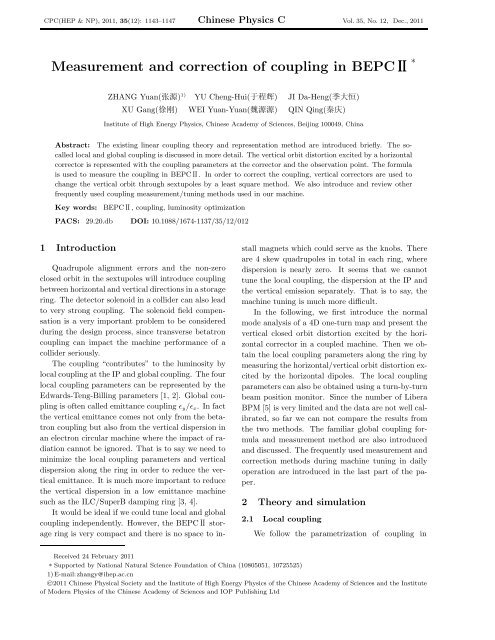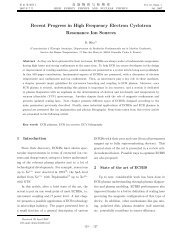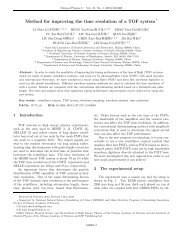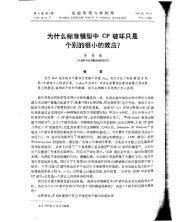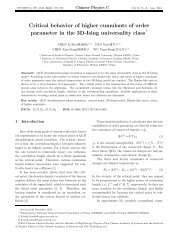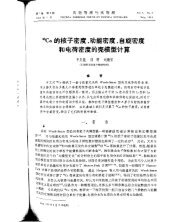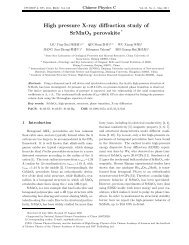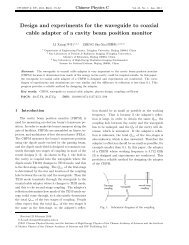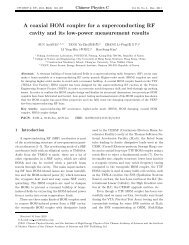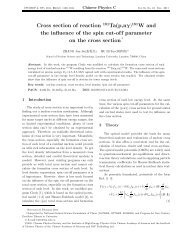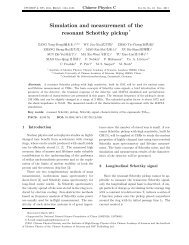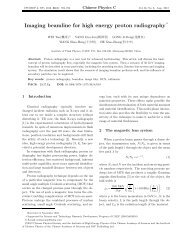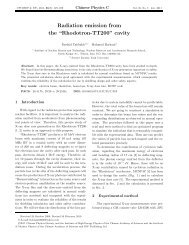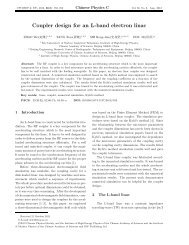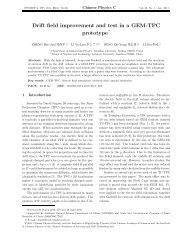Measurement and correction of coupling in BEPC
Measurement and correction of coupling in BEPC
Measurement and correction of coupling in BEPC
Create successful ePaper yourself
Turn your PDF publications into a flip-book with our unique Google optimized e-Paper software.
CPC(HEP & NP), 2011, 35(12): 1143–1147 Ch<strong>in</strong>ese Physics C Vol. 35, No. 12, Dec., 2011<strong>Measurement</strong> <strong>and</strong> <strong>correction</strong> <strong>of</strong> <strong>coupl<strong>in</strong>g</strong> <strong>in</strong> <strong>BEPC</strong> *ZHANG Yuan() 1) YU Cheng-Hui() JI Da-Heng()XU Gang() WEI Yuan-Yuan() QIN Q<strong>in</strong>g()Institute <strong>of</strong> High Energy Physics, Ch<strong>in</strong>ese Academy <strong>of</strong> Sciences, Beij<strong>in</strong>g 100049, Ch<strong>in</strong>aAbstract: The exist<strong>in</strong>g l<strong>in</strong>ear <strong>coupl<strong>in</strong>g</strong> theory <strong>and</strong> representation method are <strong>in</strong>troduced briefly. The socalledlocal <strong>and</strong> global <strong>coupl<strong>in</strong>g</strong> is discussed <strong>in</strong> more detail. The vertical orbit distortion excited by a horizontalcorrector is represented with the <strong>coupl<strong>in</strong>g</strong> parameters at the corrector <strong>and</strong> the observation po<strong>in</strong>t. The formulais used to measure the <strong>coupl<strong>in</strong>g</strong> <strong>in</strong> <strong>BEPC</strong>. In order to correct the <strong>coupl<strong>in</strong>g</strong>, vertical correctors are used tochange the vertical orbit through sextupoles by a least square method. We also <strong>in</strong>troduce <strong>and</strong> review otherfrequently used <strong>coupl<strong>in</strong>g</strong> measurement/tun<strong>in</strong>g methods used <strong>in</strong> our mach<strong>in</strong>e.Key words:<strong>BEPC</strong>, <strong>coupl<strong>in</strong>g</strong>, lum<strong>in</strong>osity optimizationPACS: 29.20.db DOI: 10.1088/1674-1137/35/12/0121 IntroductionQuadrupole alignment errors <strong>and</strong> the non-zeroclosed orbit <strong>in</strong> the sextupoles will <strong>in</strong>troduce <strong>coupl<strong>in</strong>g</strong>between horizontal <strong>and</strong> vertical directions <strong>in</strong> a storager<strong>in</strong>g. The detector solenoid <strong>in</strong> a collider can also leadto very strong <strong>coupl<strong>in</strong>g</strong>. The solenoid field compensationis a very important problem to be considereddur<strong>in</strong>g the design process, s<strong>in</strong>ce transverse betatron<strong>coupl<strong>in</strong>g</strong> can impact the mach<strong>in</strong>e performance <strong>of</strong> acollider seriously.The <strong>coupl<strong>in</strong>g</strong> “contributes” to the lum<strong>in</strong>osity bylocal <strong>coupl<strong>in</strong>g</strong> at the IP <strong>and</strong> global <strong>coupl<strong>in</strong>g</strong>. The fourlocal <strong>coupl<strong>in</strong>g</strong> parameters can be represented by theEdwards-Teng-Bill<strong>in</strong>g parameters [1, 2]. Global <strong>coupl<strong>in</strong>g</strong>is <strong>of</strong>ten called emittance <strong>coupl<strong>in</strong>g</strong> ɛ y /ɛ x . In factthe vertical emittance comes not only from the betatron<strong>coupl<strong>in</strong>g</strong> but also from the vertical dispersion <strong>in</strong>an electron circular mach<strong>in</strong>e where the impact <strong>of</strong> radiationcannot be ignored. That is to say we need tom<strong>in</strong>imize the local <strong>coupl<strong>in</strong>g</strong> parameters <strong>and</strong> verticaldispersion along the r<strong>in</strong>g <strong>in</strong> order to reduce the verticalemittance. It is much more important to reducethe vertical dispersion <strong>in</strong> a low emittance mach<strong>in</strong>esuch as the ILC/SuperB damp<strong>in</strong>g r<strong>in</strong>g [3, 4].It would be ideal if we could tune local <strong>and</strong> global<strong>coupl<strong>in</strong>g</strong> <strong>in</strong>dependently. However, the <strong>BEPC</strong> storager<strong>in</strong>g is very compact <strong>and</strong> there is no space to <strong>in</strong>stallmagnets which could serve as the knobs. Thereare 4 skew quadrupoles <strong>in</strong> total <strong>in</strong> each r<strong>in</strong>g, wheredispersion is nearly zero. It seems that we cannottune the local <strong>coupl<strong>in</strong>g</strong>, the dispersion at the IP <strong>and</strong>the vertical emission separately. That is to say, themach<strong>in</strong>e tun<strong>in</strong>g is much more difficult.In the follow<strong>in</strong>g, we first <strong>in</strong>troduce the normalmode analysis <strong>of</strong> a 4D one-turn map <strong>and</strong> present thevertical closed orbit distortion excited by the horizontalcorrector <strong>in</strong> a coupled mach<strong>in</strong>e. Then we obta<strong>in</strong>the local <strong>coupl<strong>in</strong>g</strong> parameters along the r<strong>in</strong>g bymeasur<strong>in</strong>g the horizontal/vertical orbit distortion excitedby the horizontal dipoles. The local <strong>coupl<strong>in</strong>g</strong>parameters can also be obta<strong>in</strong>ed us<strong>in</strong>g a turn-by-turnbeam position monitor. S<strong>in</strong>ce the number <strong>of</strong> LiberaBPM [5] is very limited <strong>and</strong> the data are not well calibrated,so far we can not compare the results fromthe two methods. The familiar global <strong>coupl<strong>in</strong>g</strong> formula<strong>and</strong> measurement method are also <strong>in</strong>troduced<strong>and</strong> discussed. The frequently used measurement <strong>and</strong><strong>correction</strong> methods dur<strong>in</strong>g mach<strong>in</strong>e tun<strong>in</strong>g <strong>in</strong> dailyoperation are <strong>in</strong>troduced <strong>in</strong> the last part <strong>of</strong> the paper.2 Theory <strong>and</strong> simulation2.1 Local <strong>coupl<strong>in</strong>g</strong>We follow the parametrization <strong>of</strong> <strong>coupl<strong>in</strong>g</strong> <strong>in</strong>Received 24 February 2011* Supported by National Natural Science Foundation <strong>of</strong> Ch<strong>in</strong>a (10805051, 10725525)1) E-mail: zhangy@ihep.ac.cn©2011 Ch<strong>in</strong>ese Physical Society <strong>and</strong> the Institute <strong>of</strong> High Energy Physics <strong>of</strong> the Ch<strong>in</strong>ese Academy <strong>of</strong> Sciences <strong>and</strong> the Institute<strong>of</strong> Modern Physics <strong>of</strong> the Ch<strong>in</strong>ese Academy <strong>of</strong> Sciences <strong>and</strong> IOP Publish<strong>in</strong>g Ltd
1144 Ch<strong>in</strong>ese Physics C (HEP & NP) Vol. 35Refs. [1, 2, 6]. The one-turn transfer matrix <strong>of</strong> 4Dphase space vector x = (x,x ′ ,y,y ′ ) is represented byT , written <strong>in</strong> terms <strong>of</strong> 2×2 submatrices,( )M mT = = V UV −1 , (1)n Nwhere( ) ( )A 0γI CU = ;V =; γ 2 +|C| = 1, (2)0 B −C + γIA is a 2×2 normal mode transfer matrix, which canbe represented by Courant-Snyder parameters,( )cos2πνA +α A s<strong>in</strong>2πν A β A s<strong>in</strong>2πν AA=.−γ A s<strong>in</strong>2πν A cos2πν a −α A s<strong>in</strong>2πν A(3)It is similar for B. The symplectic conjugate is( )C22 −CC + 12=. (4)−C 21 C 11In a weak <strong>coupl<strong>in</strong>g</strong> mach<strong>in</strong>e, mode A/B is similar tohorizontal/vertical oscillation, respectively. ν A /ν B isthe so-called horizontal/vertical tune. The one-turncoupled transfer matrix can be rewritten <strong>in</strong> the follow<strong>in</strong>gformT = G −1 ¯V Ū ¯V −1 G, (5)G is the Courant-Snyder transformation matrix,( ) ( √ )GA 01/ βu 0G = ; G u =0 G B α u / √ √ , (6)β u βu¯V = GV G −1 =(Ū = GUG −1 =γI−G B C + G −1A)G A CG −1BγI( )γI ¯C=− ¯C, (7)+ γI(R(2πνA ) 00 R(2πν B )), (8)where R is the rotation matrix.We restrict ourselves to a weak <strong>coupl<strong>in</strong>g</strong> mach<strong>in</strong>e,which is true <strong>in</strong> most cases. Then γ ≈ 1 along ther<strong>in</strong>g is a good approximation. The exception maybe <strong>in</strong> the IR region, where the detector solenoid <strong>and</strong>anti-solid field is very strong. When a horizontal correctorprovides a deflection θ x , the horizontal orbitdisplacement is∆x cod =θ x2s<strong>in</strong>πν x√βb,x β c,x cos(∆φ x −πν x ), (9)where ∆φ x is the horizontal betatron phase advancefrom the corrector to the observation po<strong>in</strong>t, β b /β c isthe beta function at the BPM <strong>and</strong> the corrector, respectively.The deflection <strong>in</strong> the horizontal direction wouldalso lead to a vertical orbit displacement along ther<strong>in</strong>g due to the transverse <strong>coupl<strong>in</strong>g</strong>. The vertical displacementcomes from two parts,1) the local <strong>coupl<strong>in</strong>g</strong> at BPMθ x√∆y cod,1 =− βc,x β b,y ¯Cb,22 cos(∆φ x −πν x )2s<strong>in</strong>πν xθ x√− βc,x β b,y ¯Cb,12 s<strong>in</strong>(∆φ x −πν x ).2s<strong>in</strong>πν x(10)We can notice that the first term on the right-h<strong>and</strong>side may come from the tilt error <strong>of</strong> the BPM, s<strong>in</strong>ceit is <strong>in</strong> phase with that <strong>of</strong> the horizontal distortion.2) the local <strong>coupl<strong>in</strong>g</strong> at the horizontal correctorθ x√∆y cod,2 =+ βc,x β b,y ¯Cc,11 cos(∆φ y −πν y )2s<strong>in</strong>πν y+ θ x2s<strong>in</strong>πν y√βc,x β b,y ¯Cc,12 s<strong>in</strong>(∆φ y −πν y ).(11)We can also notice that the first term on the righth<strong>and</strong>side may come from the tilt error <strong>of</strong> the corrector,s<strong>in</strong>ce it is <strong>in</strong> phase with that <strong>of</strong> the verticaldistortion excited by a vertical corrector at the position<strong>of</strong> the horizontal one. As a matter <strong>of</strong> fact, wedo not like to use the ¯C c,12 distribution as the <strong>coupl<strong>in</strong>g</strong>parametrization along the r<strong>in</strong>g due to the f<strong>in</strong>itelength <strong>of</strong> magnets, s<strong>in</strong>ce most <strong>of</strong> the horizontal correctorsare implemented us<strong>in</strong>g the redundant coils <strong>in</strong>the ma<strong>in</strong> bend<strong>in</strong>g magnets.Accord<strong>in</strong>g to the previous analysis, we can concludethat due to a horizontal deflection, ∆y codbpm is∆x codat a∆y cod∆x cod= ¯C b,22 k 1 + ¯C b,12 k 2 + ¯C c,11 k 3 + ¯C c,12 k 4 , (12)where the four coefficients k 1,2,3,4 are only related tothe decoupled l<strong>in</strong>ear optics <strong>of</strong> the mach<strong>in</strong>e. Afterthe mach<strong>in</strong>e is well calibrated by us<strong>in</strong>g the LOCOmethod[7], it is expected that we could use the theorymodel to calculate the coefficients.We performed done some simulations us<strong>in</strong>gSAD [8]. The rotation angle along the s-axis <strong>of</strong>quadrupoles is set r<strong>and</strong>omly, then we knob the horizontalcorrectors <strong>and</strong> measure the transverse orbitdistortion. By analyz<strong>in</strong>g the orbit response <strong>in</strong>formation,we can get ¯C b,12 at the BPMs. Tun<strong>in</strong>g thevertical orbit by vertical correctors could change the<strong>coupl<strong>in</strong>g</strong>, where the skewed quadrupoles come from
No. 12 ZHANG Yuan et al: <strong>Measurement</strong> <strong>and</strong> <strong>correction</strong> <strong>of</strong> <strong>coupl<strong>in</strong>g</strong> <strong>in</strong> <strong>BEPC</strong> 1145the vertical displacement through sextupoles. Fig. 1shows the real value <strong>of</strong> ¯C b,12 before/after <strong>correction</strong>.In the simulation, the emittance <strong>coupl<strong>in</strong>g</strong> is 6% before<strong>correction</strong> <strong>and</strong> reduces to 0.9% after <strong>correction</strong>.Fig. 1. Simulation study <strong>of</strong> local <strong>coupl<strong>in</strong>g</strong> measurement<strong>and</strong> <strong>correction</strong>. The horizontal axisis the BPM <strong>in</strong>dex <strong>and</strong> the vertical axis is the¯C b,12 . The figure shows the real value before(dot) <strong>and</strong> after (square dot) <strong>correction</strong>.The local <strong>coupl<strong>in</strong>g</strong> parameters could also be measuredbe us<strong>in</strong>g a turn-by-turn beam position monitor[9]. When only the A mode is excited, the transverseturn-by-turn beam position can be written asx(n) = ɛ A γ √ β A cos(2πnν A ),y(n) = ɛ A√βB√¯C 2 12 + ¯C 2 22 cos(2πnν A +∆φ A ), (13)where n is the turn number, <strong>and</strong>cos∆φ A ≡− ¯C 22√ ¯C2 12 + ¯C;222¯C 12s<strong>in</strong>∆φ A ≡ √ ¯C2 12 + ¯C.222Invert<strong>in</strong>g these expressions gives√β(A y)¯C 12 = γs<strong>in</strong>∆φ A ,β B x A¯C 22 = −γ√β(A y)cos∆φ A ,β B x A(14)(15)where (y/x) A is the ratio <strong>of</strong> the y amplitude to the xamplitude for the A mode.Similarly if only the B mode is excited, we couldmeasure the two local <strong>coupl<strong>in</strong>g</strong> parameters ¯C 12 <strong>and</strong>¯C 11 . S<strong>in</strong>ce the horizontal beam size is much largerthan the vertical one <strong>in</strong> a normal electron/positronstorage r<strong>in</strong>g, the small amplitude oscillation <strong>in</strong> thehorizontal direction is more difficult to measure. Generallyspeak<strong>in</strong>g it is not a good idea to measure thelocal <strong>coupl<strong>in</strong>g</strong> by excit<strong>in</strong>g the B mode.2.2 Global <strong>coupl<strong>in</strong>g</strong>In the smooth approximation <strong>and</strong> assum<strong>in</strong>g a uniformlydistributed skew quadrupolar field, analyticformulas are derived for a constant focus<strong>in</strong>g latticewhose s-dependent <strong>coupl<strong>in</strong>g</strong> strength j(s) is replacedby a uniform <strong>coupl<strong>in</strong>g</strong> strength given by [10]C = − 12π∮dsj(s)√β x (s)β y (s)e −i[φx(s)−φy(s)]+i(s/R)∆ ,(16)where R is the mach<strong>in</strong>e radius, s is the longitud<strong>in</strong>alcoord<strong>in</strong>ate, β <strong>and</strong> φ are the Twiss parameters <strong>of</strong> theuncoupled lattice, <strong>and</strong> ∆ the fractional distance fromthe difference resonance. Up to the first order, |C|is equivalent to the “tune difference on the <strong>coupl<strong>in</strong>g</strong>resonance”, ∆Q m<strong>in</strong> (also known as the “closest tuneapproach”). Their transverse RMS emittances arecoupled accord<strong>in</strong>g toɛ x = ɛ x0 −|C|2 ɛ x0 −ɛ y0, (17)∆ 2 +|C| 2 2ɛ y = ɛ y0 +|C|2 ɛ x0 −ɛ y0. (18)∆ 2 +|C| 2 2It should be mentioned that the equations are given<strong>in</strong> the absence <strong>of</strong> synchrotron radiation. Recent work[11] f<strong>in</strong>ds that the emittance shar<strong>in</strong>g <strong>and</strong> exchangedriven by l<strong>in</strong>ear betatron <strong>coupl<strong>in</strong>g</strong> without radiationis much more complicated. In many cases we wouldlike to use a more simplified equation for elim<strong>in</strong>at<strong>in</strong>gvertical dispersion even with radiation [12],ɛ y |C| 2=ɛ x 2∆ 2 +|C| . (19)2The m<strong>in</strong>imum tune split could also be represented bythe matrix formalizm[13],∆Q m<strong>in</strong> =det|m+ +n|π(s<strong>in</strong>µ A +s<strong>in</strong>µ B ) . (20)The most common way to adjust the <strong>coupl<strong>in</strong>g</strong> isto globally decouple the mach<strong>in</strong>e. The strengths <strong>of</strong>normal quads are adjusted to br<strong>in</strong>g the normal modetunes together. Typically the tunes cannot be madeequal. The m<strong>in</strong>imum tune split is used as a measure<strong>of</strong> the <strong>coupl<strong>in</strong>g</strong> <strong>in</strong> the mach<strong>in</strong>e. Skew quads are thenused to m<strong>in</strong>imize the tune split. F<strong>in</strong>ally the normalquads are returned to their orig<strong>in</strong>al values to br<strong>in</strong>gthe mach<strong>in</strong>e back to its normal operat<strong>in</strong>g po<strong>in</strong>t.Bagley & Rub<strong>in</strong> have po<strong>in</strong>ted out that global<strong>coupl<strong>in</strong>g</strong> is ill-def<strong>in</strong>ed [9], because the change <strong>in</strong> the(m + +n) as the tunes are brought together dependson the detailed changes <strong>in</strong> the phase advances betweenthe skew quads <strong>and</strong> the observation po<strong>in</strong>t. This
1146 Ch<strong>in</strong>ese Physics C (HEP & NP) Vol. 35<strong>in</strong> turn depends on which quads are used to br<strong>in</strong>g thetunes together. S<strong>in</strong>ce most circular mach<strong>in</strong>es run nearthe <strong>coupl<strong>in</strong>g</strong> Q x = Q y area, where the resonance densityis low, the global <strong>coupl<strong>in</strong>g</strong> method helps to someextent. Detailed <strong>coupl<strong>in</strong>g</strong> <strong>correction</strong> needs more detailedwork <strong>and</strong> we have to correct the local <strong>coupl<strong>in</strong>g</strong>along the r<strong>in</strong>g.3 Daily operation <strong>in</strong> <strong>BEPC</strong>Lum<strong>in</strong>osity performance strongly depends on themach<strong>in</strong>e condition. The <strong>coupl<strong>in</strong>g</strong> <strong>correction</strong> is animportant knob for optimization dur<strong>in</strong>g daily runs,which <strong>in</strong>cludes the vertical emittance reduction, thelocal <strong>coupl<strong>in</strong>g</strong> <strong>and</strong> even vertical dispersion parametertun<strong>in</strong>g at the IP.There are four skew quadrupoles <strong>in</strong> the arc, wheredispersion is nearly zero. They could be used to tunethe so-called global <strong>coupl<strong>in</strong>g</strong> parameters. At first, thepower supplies are unidirectional <strong>and</strong> we seldom usethe tun<strong>in</strong>g method. In that case, we use the verticalorbit bump near the sextupoles as an alternative.The 3-bump vertical orbit knob near S5 (which is themost strongest sextupole <strong>in</strong> the arc) could help ustune the lum<strong>in</strong>osity. It is unfortunate that we do notknow for sure how the vertical emittance, local <strong>coupl<strong>in</strong>g</strong>or even dispersion distortion at the IP help us,we just know that they really help.S<strong>in</strong>ce the autumn <strong>of</strong> 2010, the 4 skew quadrupoles<strong>in</strong> each r<strong>in</strong>g have commenced operation. Most <strong>of</strong>tenthey work as a knob <strong>of</strong> the local <strong>coupl<strong>in</strong>g</strong> parameterat the IP, however both the global <strong>and</strong> local <strong>coupl<strong>in</strong>g</strong>sare changed. S<strong>in</strong>ce the dispersion is nearly zero at theskew quadrupoles, we ignore the vertical dispersiondistortion caused by the knob.The m<strong>in</strong>imum tune split method is used to estimatethe emittance <strong>coupl<strong>in</strong>g</strong> <strong>in</strong> <strong>BEPC</strong>, s<strong>in</strong>ce thebeam pr<strong>of</strong>ile monitor is not well calibrated before October,2010. One quadrupole <strong>in</strong> the <strong>in</strong>jection regionis used to change the transverse tune. The m<strong>in</strong>imumtune separation is usually <strong>in</strong> the range <strong>of</strong> 0.01–0.02,<strong>and</strong> the <strong>coupl<strong>in</strong>g</strong> ɛ y /ɛ x is estimated about 1.0%–2.0%.The local vertical orbit 3-bump near S5 is used tochange the tune separation <strong>and</strong> sometimes the m<strong>in</strong>imumsplit can achieve 0.005. Dur<strong>in</strong>g the lum<strong>in</strong>osityoptimization, we do not care about the tune separationvery much. In most cases we just changethe bump <strong>and</strong> try to <strong>in</strong>crease the lum<strong>in</strong>osity. Asmentioned before, the one-quadrupole knob methodcauses beta-beat<strong>in</strong>g along the r<strong>in</strong>g <strong>and</strong> the m<strong>in</strong>imized<strong>coupl<strong>in</strong>g</strong> may be enlarged when the quadrupole is resumed.When the mach<strong>in</strong>e runs near the half-<strong>in</strong>teger region,where the lum<strong>in</strong>osity is higher, the m<strong>in</strong>imumtune split method does not work s<strong>in</strong>ce it will have tocross the synchro-betatron resonance l<strong>in</strong>e 2ν x +ν s = nwhen the transverse tunes move close to each other.Fischer [14] has developed a method for global <strong>coupl<strong>in</strong>g</strong>measurement <strong>and</strong> <strong>correction</strong>, which is based onN-turn maps fitted from turn-by-turn beam positiondata, where tune change is not needed. We have performedrelated simulations <strong>in</strong> our mach<strong>in</strong>e. It seemsthat the method does not work well. When we try toreduce the the so-called tune-split(calculated by oneturnmap) at some po<strong>in</strong>ts, it seems that the emittance<strong>coupl<strong>in</strong>g</strong> does not drop. We did not f<strong>in</strong>d a“golden” po<strong>in</strong>t where we could tune the <strong>coupl<strong>in</strong>g</strong> byits det|m + +n| value. Maybe because the mach<strong>in</strong>e isfar from a smooth one. That may show that the m<strong>in</strong>imumtune split method is not a good approximationfor us.The local <strong>coupl<strong>in</strong>g</strong> is obta<strong>in</strong>ed by analyz<strong>in</strong>g thetransverse orbit response to the horizontal correctors.When the detector’s solenoid is <strong>of</strong>f, the method istested <strong>in</strong> the BER (the electron r<strong>in</strong>g <strong>of</strong> <strong>BEPC</strong>) <strong>and</strong>the result is shown <strong>in</strong> Fig. 2.Fig. 2. Local <strong>coupl<strong>in</strong>g</strong> measurement <strong>and</strong> <strong>correction</strong><strong>in</strong> the BER with the solenoid <strong>of</strong>f. Thehorizontal axis is the BPM <strong>in</strong>dex <strong>and</strong> the verticalaxis is the ¯C b,12 .With the first <strong>correction</strong>, the vertical beam size dropsfrom 945 to 790 (r<strong>and</strong>om unit), that is to say, the verticalemittance drops to 70% <strong>of</strong> the orig<strong>in</strong>al. We alsomeasure the Touschek lifetime by measur<strong>in</strong>g the lifetimeversus the bunch current <strong>and</strong> obta<strong>in</strong> that the<strong>in</strong>verse <strong>of</strong> Touschek lifetime ratio is 33:48:95 amongthe orig<strong>in</strong>al, the 1st <strong>and</strong> 2nd <strong>correction</strong>s. S<strong>in</strong>ce theTouschek lifetime τ ∝ σ x σ y σ z , we could also obta<strong>in</strong>that the vertical emittance drops by about 50% afterthe first <strong>correction</strong> with the lifetime data. Them<strong>in</strong>imum tune split is also measured, it drops from
No. 12 ZHANG Yuan et al: <strong>Measurement</strong> <strong>and</strong> <strong>correction</strong> <strong>of</strong> <strong>coupl<strong>in</strong>g</strong> <strong>in</strong> <strong>BEPC</strong> 114712 kHz to 4 kHz for the 1st <strong>and</strong> 1 kHz for the 2nd<strong>correction</strong>. It is estimated that the vertical emittancecontributed by <strong>coupl<strong>in</strong>g</strong> drops by about 90% after the1st <strong>correction</strong> where the Eq. (19) is used. In spite<strong>of</strong> the bad co<strong>in</strong>cidence between different estimationmethods, we could conclude that the <strong>coupl<strong>in</strong>g</strong> is significantlyreduced <strong>in</strong> the r<strong>in</strong>g.When the detector solenoid <strong>and</strong> the correspond<strong>in</strong>ganti-solenoid are on, the <strong>correction</strong> method has alsobeen used successfully <strong>in</strong> our mach<strong>in</strong>e. Fig. 3 showsa typical example, where the rms size <strong>of</strong> ¯c 12 has beenreduced by about 80% to 0.009.The 4 transverse <strong>coupl<strong>in</strong>g</strong> parameters at the IPcould be tuned with the 4 skew quadrupoles. An alternativemethod is used to change the vertical orbit<strong>in</strong> the sextupoles, where the vertical dispersion at theIP is also disturbed. That is to say, we could tune fourx-y <strong>coupl<strong>in</strong>g</strong> parameters <strong>and</strong> two vertical dispersionsat the IP by chang<strong>in</strong>g the vertical orbit <strong>in</strong> sextupoles.It is expected that the tun<strong>in</strong>g would not change theorbit at the IP, <strong>in</strong>jection region, RF region <strong>and</strong> northIP (where the two collid<strong>in</strong>g beams are separated verticallyto avoid the parasitic beam-beam effect). Theprelim<strong>in</strong>ary experiments show that the method is notfeasible s<strong>in</strong>ce the vertical orbit distortion could notbe ignored.4 Summary & discussionFig. 3. Local <strong>coupl<strong>in</strong>g</strong> <strong>correction</strong> with thesolenoid on. The horizontal axis is the BPM<strong>in</strong>dex <strong>and</strong> the vertical axis is the ¯C b,12 .The error <strong>of</strong> local <strong>coupl<strong>in</strong>g</strong> measurement comesfrom the beta beat<strong>in</strong>g from the theory model <strong>and</strong> theBPM resolution. The sextupole <strong>and</strong> vertical magnetstrength error would also contribute to the <strong>correction</strong>errors. S<strong>in</strong>ce the wiggler 4w1 is also runn<strong>in</strong>g <strong>in</strong> theBER, the LOCO method has shown that the opticdistortion is more serious <strong>in</strong> the BER than that <strong>in</strong>the BPR (the positron r<strong>in</strong>g <strong>of</strong> <strong>BEPC</strong>).In <strong>BEPC</strong> the solenoid <strong>of</strong> the detector is wellcompensated by the anti-solenoid on both sides <strong>of</strong> theIP [15, 16]. It is believed that the <strong>coupl<strong>in</strong>g</strong> ma<strong>in</strong>lycomes from alignment error <strong>and</strong> the vertical orbitthrough the sextupoles. Coupl<strong>in</strong>g tun<strong>in</strong>g knobs are<strong>in</strong>dispensable to the lum<strong>in</strong>osity optimization.In this paper we present a formula by which wecould obta<strong>in</strong> the local <strong>coupl<strong>in</strong>g</strong> parameters at theBPM us<strong>in</strong>g the orbit response <strong>in</strong>formation <strong>in</strong>stead<strong>of</strong> the s<strong>in</strong>gle-pass BPM. This method has been successfullyused to measure <strong>and</strong> correct the <strong>coupl<strong>in</strong>g</strong><strong>in</strong> our mach<strong>in</strong>e. We also <strong>in</strong>troduce other <strong>coupl<strong>in</strong>g</strong>knobs for normal operation. The local <strong>coupl<strong>in</strong>g</strong> atthe IP <strong>and</strong> the global <strong>coupl<strong>in</strong>g</strong> could not be tuned<strong>in</strong>dependently <strong>in</strong> <strong>BEPC</strong>, which would br<strong>in</strong>g moretrouble to the lum<strong>in</strong>osity optimization. In our local<strong>coupl<strong>in</strong>g</strong> <strong>correction</strong>, so far we have not considered thevertical dispersion <strong>correction</strong>.We wish to thank the members <strong>of</strong> the <strong>BEPC</strong>commission<strong>in</strong>g group for their hard work.References1 Edwards D, Teng L, IEEE Trans. Nucl. Sci., 1973, 20: 32 Bill<strong>in</strong>g M. Cornell Report No. CBN 85-2, 19853 Panagiotidis K, Wolski A, Korostelev M. Proceed<strong>in</strong>gs <strong>of</strong>IPAC10, Kyoto, Japan, 46024 Liuzzo S M, Biag<strong>in</strong>i M E, Raimondi P, Donald M H. Proceed<strong>in</strong>gs<strong>of</strong> IPAC10, Kyoto, Japan, 15305 Instrumentation Technologies, http://www.i-tech.si6 Sagan D, Rub<strong>in</strong> D. Phys. Rev. ST-AB, 1999, 2: 0740017 WEI Y Y. Analysis <strong>of</strong> <strong>BEPC</strong> Optics Us<strong>in</strong>g Orbit ResponseMatrix, Proceed<strong>in</strong>gs <strong>of</strong> PAC2007, Albuquerque,USA8 Hirata K. An Introduction to SAD, CERN 88-04, 19889 Bagley P, Rub<strong>in</strong> D. Proceed<strong>in</strong>gs <strong>of</strong> PAC 1989, 87410 M<strong>in</strong>ty M, Zimmermann F. <strong>Measurement</strong> <strong>and</strong> Control <strong>of</strong>Charged Particle Beams. Berl<strong>in</strong>: Spr<strong>in</strong>ger, 2003. ISBN 3-540-44197-511 Franchi A, Metral E, Tomas R. Phys. Rev. ST-AB, 2007,10: 06400312 Guignard G. Phys. Rev. E, 1995, 51: 6104–611813 Schanch<strong>in</strong>ger L, Talman R. Manual for the ProgramTEAPOT, Non<strong>in</strong>teractive FORTRAN Version, AppendixG, 199614 Fischer W. Phys. Rev. ST-AB, 2003, 6: 06280115 YU Cheng-Hui, WU Y<strong>in</strong>g-Zhi, XU Gang. HEP & NP, 2005,29: 418–423 (<strong>in</strong> Ch<strong>in</strong>ese)16 YU Cheng-Hui et al. Nucl. Instrum. Methods A, 2009, 608:234–237


